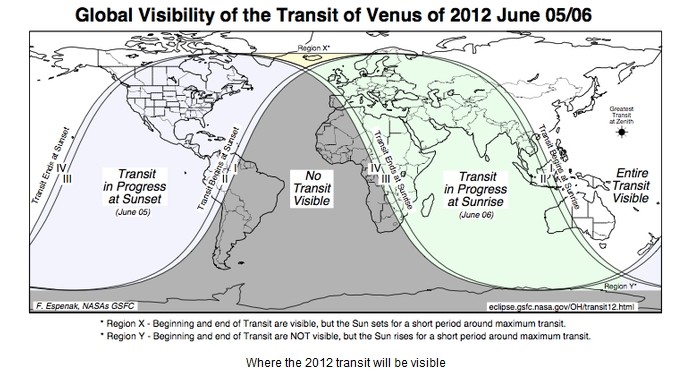Transits of Venus are very rare, coming in pairs separated by more than a hundred years. This June’s transit, the bookend of a 2004-2012 pair, won’t be repeated until the year 2117. Fortunately, the event is widely visible. Observers on seven continents, even a sliver of Antarctica, will be in position to see it.

The nearly 7-hour transit begins at 3:09 pm Pacific Daylight Time (22:09 UT) on June 5th. The timing favors observers in the mid-Pacific where the sun is high overhead during the crossing. In the USA, the transit will be at its best around sunset. That’s good, too. Creative photographers will have a field day imaging the swollen red sun “punctured” by the circular disk of Venus.
Observing tip: Do not stare at the sun. Venus covers too little of the solar disk to block the blinding glare.
ASA (USA)
http://venustransit.nasa.gov/2012/transit/
NASA Edge
http://www.nasa.gov/multimedia/podca…dge/index.html
University of Barcelona (from a telescope in Norway)
https://gaia.am.ub.es/serviastro/www…ive/index.html
National Solar Observatory
http://venustransit.nso.edu/live.html
Exploratorium (via the Mauna Loa Observatory)
http://www.exploratorium.edu/venus/
NASA TV
http://www.nasa.gov/ntv
Coca Cola Space Science Center (from Australia)
http://www.ccssc.org/transit2012.html
Bareket observatory (Israel)
http://www.bareket-astro.com/live-as…june-2012.html
Mt. Lemmon Sky Center
http://skycenter.arizona.edu/annoucement/live
Astronomers Without Borders (from Mt. Wilson, California)
http://www.astronomerswithoutborders…e-webcast.html
The 2012 Transit of Venus using HAM Radio
http://aprs.org/VenusTransit2012.html
Transit of Venus Special Event June 6, 2012
http://www.southgatearc.org/news/may…cial_event.htm
Courtesy of nasa.com


